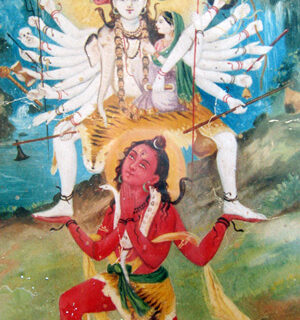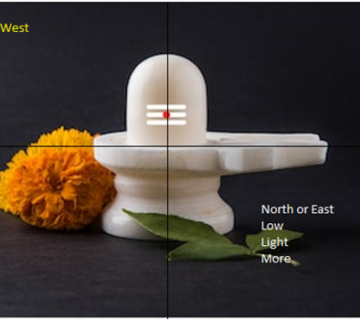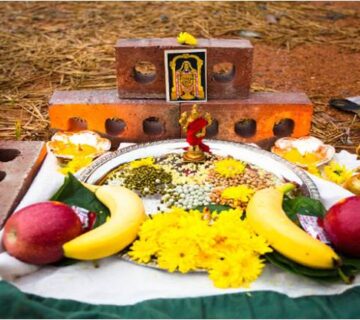Vastu is derived from the word ‘Vasa’ which refers to any piece or portion of the site of construction. The development of Vastu in India as tradition can be traced in three regions which are- Firstly, the Northern region of Rsi Kashyap well known as ‘Naga Pradesh’, Secondly, a place of Asuras known as the ‘Vesara’ was the land between the vindhya mountains and the river Krishna and Tungabhadra and lastly, the reign of the southern part by Rsi Bhrigu which widely followed the Naga Pradesh.
Vastu Purusha and Vastu Purusha Mandala: A Core Understanding of the Fundamentals of Vastu Shastra
The creation of the ‘Vastu Purusha Mandala’ is a fascinating story from ancient Indian texts, depicting the birth of the ‘Vastu Purusha’, the chaos he caused and how he was overpowered by collective efforts of different Gods. All ancient texts provide a detailed description about the creation of Vastu Purusha. The ‘Vishkarma Prakash’ narrates the story about the origin of Vastu Shastra is related to the birth of Vastu Purusha.
 In the era of the Treta Yuga, it all started when Lord Brahma created various forms of creatures and were experimenting by creating humans. He thought that a ‘man’ would be the best option for this and so he created a man. But this was not an ordinary man, he was huge and had enormous powers to grow. Soon after his creation, the man started growing. As time passed, he became enormous and with his size, his hunger also increased. He started to consume everything that came in his way. In no time, he became so monstrous that his shadow had cast a permanent eclipse on earth. When he walked, the Earth trembled. When he breathed, the winds blew and he drank the water, the water level of the Earth went down.
In the era of the Treta Yuga, it all started when Lord Brahma created various forms of creatures and were experimenting by creating humans. He thought that a ‘man’ would be the best option for this and so he created a man. But this was not an ordinary man, he was huge and had enormous powers to grow. Soon after his creation, the man started growing. As time passed, he became enormous and with his size, his hunger also increased. He started to consume everything that came in his way. In no time, he became so monstrous that his shadow had cast a permanent eclipse on earth. When he walked, the Earth trembled. When he breathed, the winds blew and he drank the water, the water level of the Earth went down.
This entire incident was enough for all Gods including Indra Deva to press the panic button. They immediately rushed to Brahma and requested him to stop the man from spreading the chaos.
 Lord Brahma realized that he had made a terrible mistake and he thought to rectify it. So he suggested all devas to join, the Gods of eight directions (Astha Dikapalakas) to come and help him. Upon hearing his request, all 45 deities came for rescue, they grabbed the man and overpowered him. They pinned the man against the ground with his head in North-East and legs in South-West direction. Lord Brahma pressed him down in the middle. This was a story of how the ‘Vastu Purusha Mandala’ was formed and an immense destructive force was controlled by Lord Brahma along with the 45 deities.
Lord Brahma realized that he had made a terrible mistake and he thought to rectify it. So he suggested all devas to join, the Gods of eight directions (Astha Dikapalakas) to come and help him. Upon hearing his request, all 45 deities came for rescue, they grabbed the man and overpowered him. They pinned the man against the ground with his head in North-East and legs in South-West direction. Lord Brahma pressed him down in the middle. This was a story of how the ‘Vastu Purusha Mandala’ was formed and an immense destructive force was controlled by Lord Brahma along with the 45 deities.
 Thereafter, Lord Brahma gave the title of the ‘Vastu Purusha’ to that man. The ‘Vastu Purusha’ was born on Krishna Paksha, Tritya Tithi, Bhadrapada Masa, Shani Vara, Kritika Naksatra,Vyatipat Yoga, Vishti Karan during Bhadra in Kulika Muhurta. This was the time when for the first time, the fundamentals and guidelines of Vastu were introduced to mankind in ancient Indian Architecture.
Thereafter, Lord Brahma gave the title of the ‘Vastu Purusha’ to that man. The ‘Vastu Purusha’ was born on Krishna Paksha, Tritya Tithi, Bhadrapada Masa, Shani Vara, Kritika Naksatra,Vyatipat Yoga, Vishti Karan during Bhadra in Kulika Muhurta. This was the time when for the first time, the fundamentals and guidelines of Vastu were introduced to mankind in ancient Indian Architecture.

In this event, the Vastu Purusha was badly terrified and he surrendered himself in front of Lord Brahma. As a result Vastu Purusha was blessed by the universal creator. Lord Brahma was very happy at the innocence of this demon. Lord Brahma said “I will make you immortal and all mortal people who will build any sort of structure on earth will worship you.” Therefore, whether in villages or cities, palace or town, before the construction of houses, water bodies and gardens, humans would worship the Vastu Purusha and feed him with various items. Lord Brahma set the Vastu Purusha at liberty to tease, devour and trouble if humans fail to worship him from time to time. The Lord further stated that the one who will fail to worship the Vastu Purusha would face severe consequences. His presence will be in all the sites and will be recognized as the Vastu Purusha. Vastu Purusha brings harmony and balances the energies within and around the said architectural structure.
This story teaches us to understand the orientation of balancing all the 45 energies present in the mandala to create a peaceful and harmonious surrounding which is used to create the Manushayalaya and the Devalaya.
The Vastu Purusha Mandala is an indispensable part of Vastu Shastra and constitutes the mathematical and diagrammatic basis for generating design. It is the metaphysical plan of a building that incorporates the course of the heavenly bodies and supernatural forces.
‘Purusha’ defines energy, power, soul or cosmic man whereas the‘Mandala’ is the generic name for any plan or chart which symbolically represents the cosmos. It is also a creation of plans which are well divided to create space for living or residing.
This incident which defines the creation of a huge demon to a Vastu Purusha is depicted graphically in the Vastu Purusha Mandala with portions allocated hierarchically to each deity based on their contributions and positions. Brahma occupied the central portion- the Brahmasthana and other Gods were distributed around in a concentric pattern.
There are 45 gods in all including 32 outer deities.
- North- Kubera– Ruled by lord of wealth (Finance and opportunities )
- South- Yama– Ruled by lord of death – Yama(strengthening)
- East- Indra– Ruled by the solar deity- Aditya (sources/resources )
- West- Varuna– Ruled by lord of Ocean (Physical)
- Northeast- Eshanya – Ruled by Shiva(gyana/value/virtues)
- Southeast– Agni– Ruled by the fire deity – Agni (Energy Generating)
- Northwest– Vayu– ruled by the god of winds (Action /creation )
- Southwest– Pitru/Nairutya, Niruthi– Ruled by ancestors (pitrs)
- Center- Brahma– Ruled by the creator of the universe (Manifestation/navel)

Let me introduce you to Paisacha, this is a zone which works like a sheath to the mandala one has created for commercial or residence use.
 Paisacha is the 1/9th of the layout from all four sides. The energies present here works like a guard to the people residing in. Every home need to be constructed by leaving Paisacha zone around all the sides.
Paisacha is the 1/9th of the layout from all four sides. The energies present here works like a guard to the people residing in. Every home need to be constructed by leaving Paisacha zone around all the sides.
Types of Mandalas
The central area in all mandala is the Brahmasthana. Mandala ‘circle-circumference’ or ‘completion’, is a concentric diagram having spiritual and ritual significance in both Buddhism and Hinduism.

The space occupied by it varies in different Mandala– in Pitha (9) and Upapitha (25) it occupies one square module, in Mahaapitha (16), Ugrapitha (36) and Manduka (64), four square modules and in Sthandila (49) and Paramasaayika (81), nine square modules.
In Hindu cosmology, the surface of the earth is represented as a square or spiral, the most fundamental of forms. The earth is represented as four-cornered in reference to
the horizon’s relationship with sunrise and sunset, the North and South direction. It is four cornered spirals used to create a perfect mandala which represented in the form of the Prithvi Mandala.
 The Pitha is an amplified Prithvimandala in which, according to some texts, the central space is occupied by the Earth. The Sthandila Mandala is used in a concentric manner.
The Pitha is an amplified Prithvimandala in which, according to some texts, the central space is occupied by the Earth. The Sthandila Mandala is used in a concentric manner.
The most important mandala are the Paramasaayika Mandala of 81 squares and especially the Manduka/ Chandita Mandala of 64 squares.
The normal position of the Vastu Purusha (head in the northeast, legs in the southwest) is as depicted in the Paramasaayika Mandala. However, in the Manduka Mandala, the Vastu Purusha is depicted with the head facing east and the feet facing west.
Following are the difference types of mandala created for different layouts:
 The Mandala is put to use in site planning and architecture through a process called the Pada Vinyasa. This is a method whereby any site can be divided into grids/ modules or Pada. Depending on the position of the Gods occupying the various modules, the zoning of the site and disposition of functions in a building are arrived at.
The Mandala is put to use in site planning and architecture through a process called the Pada Vinyasa. This is a method whereby any site can be divided into grids/ modules or Pada. Depending on the position of the Gods occupying the various modules, the zoning of the site and disposition of functions in a building are arrived at.
A site of any shape can be divided using the Pada Vinyasa. Sites are known by the number of divisions on each side. The types of Mandalas with the corresponding names of sites is given below.
- Sakala (1 square)corresponds to Eka-pada (single divided site)
- Pechaka (4 squares) corresponds to Dwi-pada (two divided site)
- Pitha (9 squares) corresponds to Tri-pada (three divided site)
- Mahaapitha (16 squares) corresponds to Chatush-pada(four divided site)
- Upapitha (25 squares) corresponds to Pancha-pada(five divided site)
- Ugrapitha (36 squares) corresponds to Shashtha-pada(six divided site)
- Sthandila (49 squares) corresponds to sapta-pada(seven divided site)
- Manduka/ Chandita (64 square) corresponds to Ashta-pada (eight divided site)
- Paramasaayika (81 squares) corresponds to Nava-pada(nine divided site)
- Aasana (100 squares) corresponds to Dasa-pada (ten divided site)
The concept of Sakala and Nishkala are applied in buildings appropriately. In temples, the concepts of Sakala and Nishkala are related to the two aspects of the Hindu idea of worship- Sagunopaasana, the supreme as personal God with attributes and Nirgunopaasana, the supreme as absolute spirit unconditioned by attributes.
 Correspondingly, the Sakala, complete in itself, is used for shrines of gods with form (Sakalamoorthy) and to perform Yajna (fire rites). However the Nishkala is used for installation of idols without form- Nishkalamoorthy– and for auspicious, pure performances. The amorphous center is considered beneficial to the worshippers, being a source of great energy. This could also be used for settlements. In commercial buildings, only odd numbers of modules are
Correspondingly, the Sakala, complete in itself, is used for shrines of gods with form (Sakalamoorthy) and to perform Yajna (fire rites). However the Nishkala is used for installation of idols without form- Nishkalamoorthy– and for auspicious, pure performances. The amorphous center is considered beneficial to the worshippers, being a source of great energy. This could also be used for settlements. In commercial buildings, only odd numbers of modules are
prescribed as the Nishkala or amorphous center would cause too high a concentration of energy for human occupants. Even here, the Brahmasthana is left open to the sky.
In Mandala, certain sensitive points are known as the Marma points, which are the vital energy spots on which nothing should be built. They are determined by certain proportional
relationships of the squares and the diagonals.
Puja, Havan, Homa and other rituals play the vital role for site which are under construction, starting from bhumi poojan to house warming, known as Graha parvash. The muhurta or the auspicious time needs to be refered from Panchang.
OMTATSAT








No comment